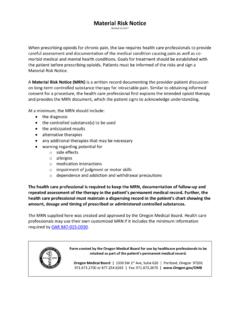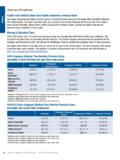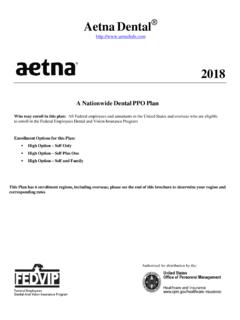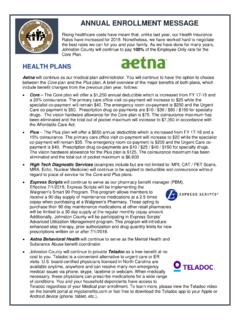Transcription of PEBB Open Enrollment Guide - oregon.gov
1 Optional insurance Optional employee or Spouse/Domestic Partner Life Insurance You can enroll in or increase optional life insurance for yourself and your spouse or partner during Open Enrollment . There is no guaranteed issue available during open Enrollment . You must complete the medical history statement by December 15, 2017. You pay the full premium for this coverage. Applications require approval of a medical history statement. This is term life. The policy pays if you (the subscriber who purchases the coverage) are still a PEBB-eligible state employee , and the premium payments are current. Higher tobacco rates apply to individuals who have used tobacco in the prior 12 months. The premium rates increase when the age of covered individuals moves them into a new age tier.
2 All age-related tier rate changes are held until the next plan year and go into effect Jan. 1 of that year. Optional Life Insurance Monthly Premium Rates (Non-Tobacco) per $10,000 in coverage*. Thru 75 &. Age Tier 25-29 30-34 35-39 40-44 45-49 50-54 55-59 60-64 65-69 70-74. 24 up Rate Per $ $ $ $ $ $ $ $ $ $ $ $ $10,000. *Purchased in $20,000 increments, only Optional Life Insurance Monthly Premium Rates (Tobacco) per $10,000 in coverage*. Thru 75 &. Age Tier 25-29 30-34 35-39 40-44 45-49 50-54 55-59 60-64 65-69 70-74. 24 up Rate Per $ $ $ $ $ $ $ $ $ $ $ $ $10,000. *Purchased in $20,000 increments, only Optional Optional Dependent Life Insurance You pay the full premium for this term life insurance that covers all your PEBB-eligible dependents and your spouse or partner for the single premium payment of $ per month to cover the entire group.
3 The benefit amount is $5,000 per person. You, the beneficiary, receive the benefit payment to cover the entire group if the covered person dies while covered under the policy, and you are still a PEBB-eligible state employee , and premium payments for the coverage are current. Accidental Death & Dismemberment Insurance (AD&D). The AD&D plan provides 24-hour coverage for accidental loss of life, limb, hand, foot, hearing, speech, sight or thumband index finger (of the same hand). You pay the full premium for this insurance. The premium rate for you as the employee is $ per $50,000 in coverage. The family rate ( employee and PEBB-eligible dependents) is $ per $50,000 in coverage. You may select a coverage amount from $50,000 to $500,000 in increments of $50,000.
4 This is a summary only. See the plan documents for details. In the case of a discrepancy, the plan document will apply. Public Employees' Benefit Board 2018 Enrollment Guide 15. Optional insurance Short-Term Disability Insurance This insurance covers a portion of your salary if you become disabled (as defined in the policy). for a short period. You pay the full amount for this coverage. Premium rate = x gross monthly salary. Example: x $3,234 (gross monthly salary) = $ monthly premium deducted from salary. Following a 7-day benefit waiting period, this insurance covers 60 percent of your insured earnings. The insured earnings amount is based on your weekly earnings in effect on your last full day of work.
5 When your insured earnings increase (for example, with a pay increase), your premium rate increases. Insured earnings does not include overtime pay, bonuses or dollars received when you opt out of medical coverage. The maximum of insured earnings for short-term disability insurance is limited to $2,769. The maximum weekly benefit is $1,662 before reduction of deductible income. The minimum weekly benefit is $25 following reduction of deductible income. The benefit if you are disabled less than one week is one-seventh of the weekly benefit for each day you are disabled. Deductible income means other income you are eligible to receive because of your disability. Long-Term Disability Insurance This insurance covers a portion of your salary if you become disabled (as defined in the policy) for a long period.
6 You pay the full amount for this coverage. You determine the benefit percentage of your monthly insured earnings when you choose from the four options. For long- term disability, the insured earnings amount is based on your monthly earnings in effect on your last full day of work. When your insured earnings increase (for example, with a pay increase), your premium rate increases. Insured earnings do not include overtime pay, bonuses, or dollars received when you opt out of medical coverage. Long-term Disability Premium Rates Optional Premium = Rate x month salary Option Premium Rate Waiting Period Coverage Coverage Maximum/Minimum 1 $ 90 days 60% of first $12,000 minus $7,200 before reduction by deductible 2 $ 180 days deductible income income/$50.
7 3 $ 90 days 66 2/3% of first $12,000 minus $8,000 before reduction by deductible 4 $ 180 days deductible income income/$50. Here is an example of determining premium rate. You choose option 1 with a 90-day waiting period and a monthly benefit amount of 60 percent of your pre-disability earnings. Your gross monthly salary (before any deductions) $1,900. Times premium X Premium amount you pay each month $ This is a summary only. See the plan documents for details. In the case of a discrepancy, the plan document will apply. 16 Public Employees' Benefit Board 2018 Enrollment Guide Optional insurance The long-term disability benefit is a percentage of the first $12,000 of your pre-disability earnings. The maximum monthly benefit (before reduction of deductible income) is $7,200 if you choose option 1 or 2, or $8,000 if you choose option 3 or 4.
8 The minimum is $50. The maximum weekly benefit is $1,662 before reduction of deductible income. Deductible income means other income you are eligible to receive because of your disability. Long Term Care Insurance You may enroll in this insurance at any time for open Enrollment you must enroll on the Unum website at Long term care insurance provides benefits when you are unable to perform at least two activities of daily living (ADLs). ADLs are dressing, bathing, transferring, toileting, eating and continence. You are eligible for a monthly benefit after you meet all these conditions: You become Disabled;. You are receiving services in a Long Term Care Facility or Assisted Living Facility/Adult Foster Home; or Professional Home Care Services if your plan includes a Professional Home Care Services benefit; or Total Home Care if your plan includes a Total Home Care benefit.
9 You have satisfied your Elimination Period; and A Physician has certified that you are unable to perform, without Substantial Assistance from another individual, two or more ADLs for a period of at least 90 days, or that you require Substantial Supervision by another individual to protect you and others from threats to health or safety due to Severe Cognitive Impairment. You will be required to submit a Physician certification every 12 months. The amount of your monthly benefit will be based on the coverage options you chose and the place of residence used for long term care. If your coverage includes Professional Home Care Services, the benefit payment will be based on the number of days you receive these services.
10 You should read the entire policy and review all rates; they are available on the plan's website: Optional Public Employees' Benefit Board 2018 Enrollment Guide 17.













